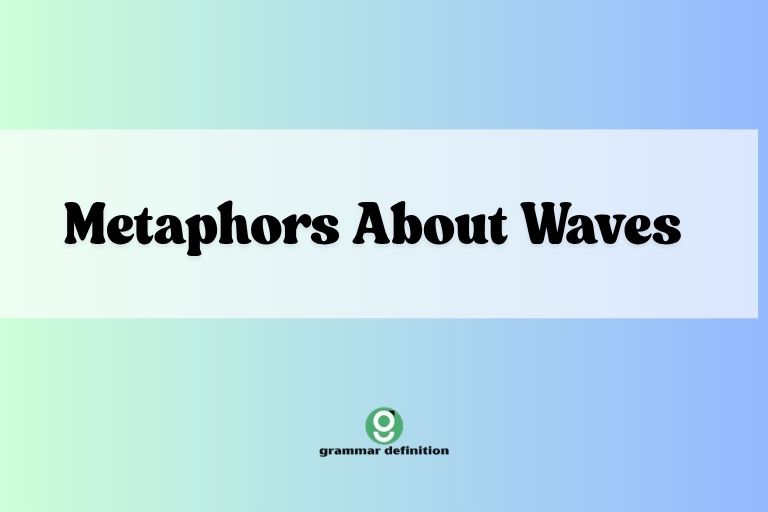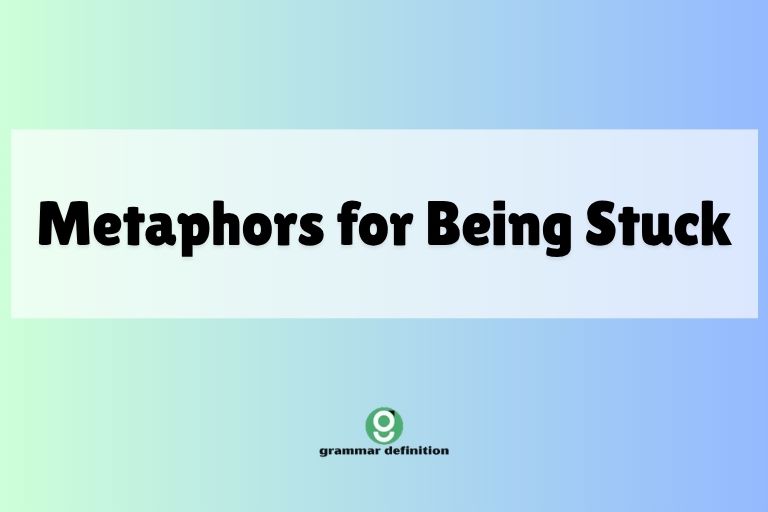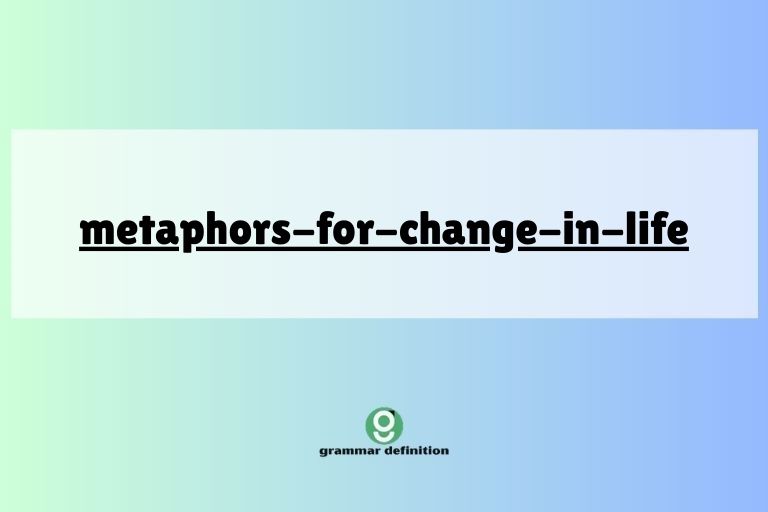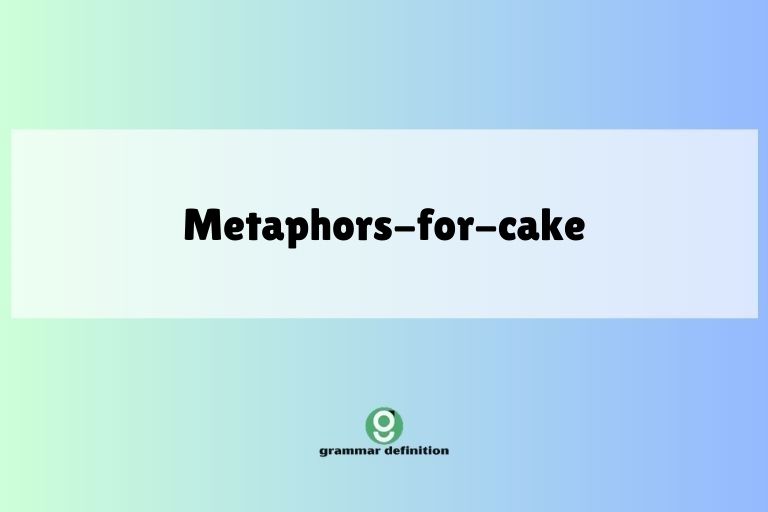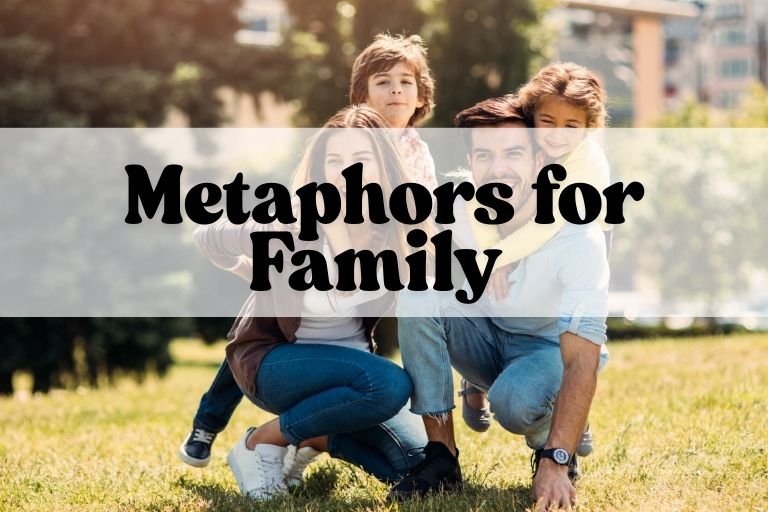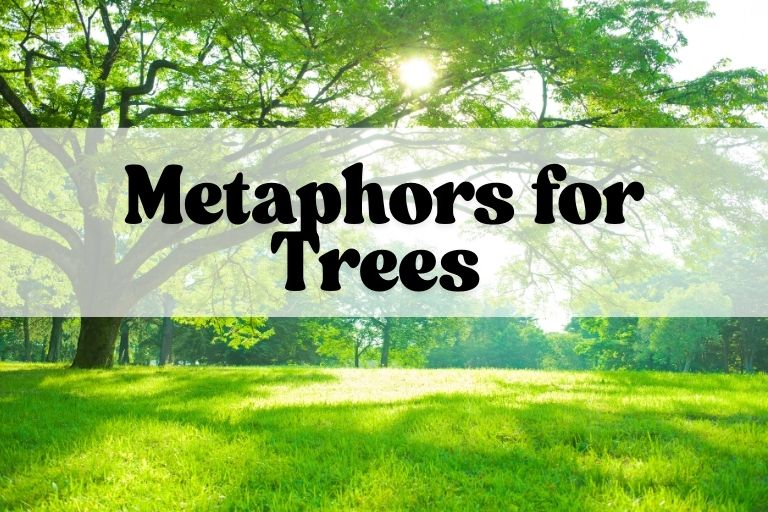Nature’s Echo: Mastering Metaphors in English Grammar
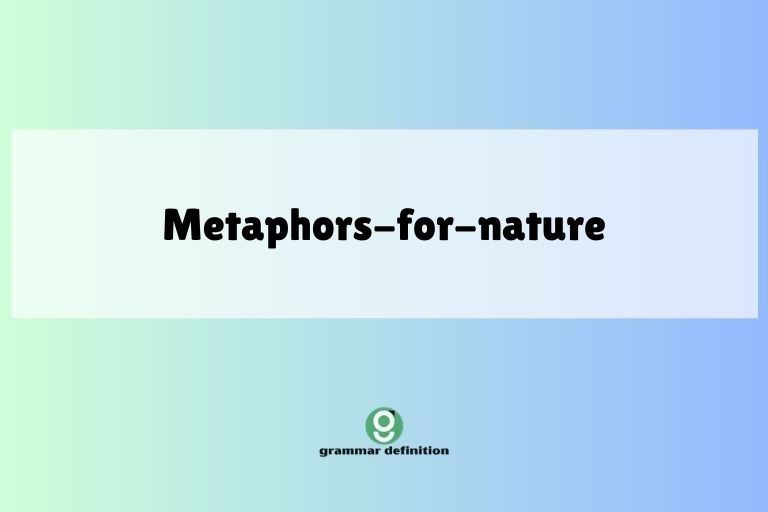
Metaphors are powerful tools in the English language, allowing us to understand abstract concepts by relating them to something more concrete. When applied to nature, metaphors can evoke vivid imagery, deepen our understanding of the natural world, and add richness to our writing and speech.
This article explores the use of metaphors for nature, focusing on their grammatical structure, various types, and practical applications. Whether you’re a student, writer, or language enthusiast, understanding nature metaphors will enhance your ability to communicate effectively and appreciate the beauty of the English language.
This guide provides detailed explanations, examples, and exercises to help you master this fascinating aspect of grammar.
By understanding the nuances of metaphors as they relate to the natural world, you unlock a deeper appreciation for both language and the environment. This understanding not only strengthens your grasp of English grammar but also enriches your creative expression, allowing you to paint vivid pictures with words and convey complex ideas with clarity and impact.
Let’s delve into the world of nature metaphors and explore their limitless possibilities.
Table of Contents
- Introduction
- Definition of Metaphor
- Nature Metaphors Explained
- Structural Breakdown
- Types of Metaphors
- Examples of Nature Metaphors
- Usage Rules
- Common Mistakes
- Practice Exercises
- Advanced Topics
- FAQ
- Conclusion
Definition of Metaphor
A metaphor is a figure of speech that directly compares two unrelated things, asserting that one thing is another. Unlike similes, which use words like “like” or “as” to make a comparison, metaphors imply a resemblance without explicitly stating it. The power of a metaphor lies in its ability to create a vivid image or convey a deeper meaning by transferring qualities from one thing to another. This transfer of qualities allows for a more profound understanding and emotional connection.
Metaphors are essential for enriching language, making complex ideas more accessible, and adding depth to writing and speech. They are used extensively in literature, poetry, everyday conversation, and even scientific discourse.
A well-crafted metaphor can transform an ordinary sentence into something memorable and impactful, and it is a critical skill to develop for effective communication.
Nature Metaphors Explained
Nature metaphors apply metaphorical comparisons using elements and concepts from the natural world. These metaphors can involve animals, plants, weather phenomena, landscapes, and natural processes.
By drawing parallels between human experiences and the natural world, these metaphors can evoke powerful imagery and convey complex emotions or ideas in a relatable way. They help us see the world in a fresh, insightful manner.
Using nature metaphors effectively requires a good understanding of both the literal meaning of the natural elements and their symbolic associations. For example, a “stormy relationship” uses the intensity and chaos of a storm to describe a turbulent connection between people.
These metaphors can add depth and nuance to your writing and speech, making them more engaging and memorable for your audience. They also allow you to tap into universal human experiences and emotions, creating a stronger connection with your readers or listeners.
Structural Breakdown
The basic structure of a metaphor involves two key components: the tenor and the vehicle. The tenor is the subject to which the metaphor refers, and the vehicle is the image or concept used to represent the tenor. In a nature metaphor, the vehicle is always an element of nature. Understanding this structure helps in analyzing and creating effective metaphors.
For instance, in the metaphor “He is a towering oak,” the tenor is “he” (the person being described), and the vehicle is “a towering oak.” The qualities associated with a towering oak – strength, resilience, and longevity – are transferred to the person, suggesting that he possesses similar characteristics. Recognizing the tenor and the vehicle allows you to dissect the metaphor and understand the intended meaning and effect.
The context in which the metaphor is used also plays a crucial role in interpreting its meaning accurately.
Types of Metaphors
Nature metaphors can be categorized based on the specific elements of nature used as the vehicle. Here are some common types:
Personification
Personification is a type of metaphor where human qualities or actions are attributed to inanimate objects or abstract concepts. When applied to nature, it involves giving human traits to natural elements like the wind, the sun, or the mountains.
This can make descriptions more vivid and relatable.
Examples of personification in nature metaphors include “The wind whispered secrets through the trees” and “The sun smiled down on the earth.” These metaphors create a sense of connection and intimacy with the natural world, making it feel more alive and responsive. Personification is a powerful tool for evoking emotions and creating a sense of wonder in writing and speech.
Animalistic Metaphors
Animalistic metaphors use animals and their characteristics to describe people, objects, or situations. These metaphors can highlight certain qualities or behaviors associated with specific animals.
They rely on commonly understood associations, such as the cunning of a fox or the bravery of a lion.
For example, saying someone is “as sly as a fox” implies that they are cunning and deceitful. Similarly, describing a leader as “a lion in battle” suggests courage and ferocity.
Animalistic metaphors add a layer of depth and imagery to descriptions, making them more engaging and memorable. They are often used to convey complex emotions or ideas in a concise and impactful way.
Elemental Metaphors
Elemental metaphors use elements such as fire, water, earth, and air to represent abstract concepts or human characteristics. These metaphors draw on the symbolic meanings associated with each element to convey deeper meanings.
They are particularly effective in expressing intense emotions or describing fundamental aspects of life.
For instance, describing someone’s anger as “a raging fire” conveys the intensity and destructiveness of their emotions. Similarly, referring to someone as “grounded like the earth” suggests stability and reliability.
Elemental metaphors tap into primal associations, making them powerful tools for communication and expression. They are frequently used in literature, mythology, and everyday speech to add layers of meaning to descriptions and narratives.
Plant-Based Metaphors
Plant-based metaphors use plants, trees, and flowers to symbolize various qualities, emotions, or situations. These metaphors draw on the symbolic meanings associated with different plants, such as the resilience of a tree or the beauty of a flower.
They can add a touch of elegance and natural imagery to writing and speech.
For example, describing someone’s love as “a blossoming flower” suggests growth, beauty, and potential. Similarly, referring to someone as “rooted like a tree” implies stability and strength.
Plant-based metaphors are often used to convey ideas related to growth, transformation, and the cyclical nature of life. They can also evoke a sense of peace and tranquility, making them particularly effective in descriptive writing and poetry.
Examples of Nature Metaphors
Here are several examples of nature metaphors, categorized by type, to illustrate their usage and impact.
Personification Examples
The following table provides examples of personification in nature metaphors. These examples illustrate how natural elements are given human-like qualities to create vivid and relatable imagery.
| Metaphor | Explanation |
|---|---|
| The river sighed as it flowed through the valley. | The river is given the human action of sighing, suggesting a sense of weariness or contentment. |
| The mountains stood guard over the sleeping town. | The mountains are personified as guardians, protecting the town below. |
| The forest whispered secrets to those who listened. | The forest is given the ability to whisper, implying a sense of mystery and hidden knowledge. |
| The sun peeked shyly from behind the clouds. | The sun is described as peeking shyly, giving it a human-like demeanor of coyness. |
| The rain wept tears of sorrow onto the parched earth. | The rain is personified as weeping, conveying a sense of sadness and relief for the dry land. |
| The wind howled in anger as it swept across the plains. | The wind is described as howling in anger, suggesting a forceful and destructive nature. |
| The stars winked mischievously in the night sky. | The stars are personified as winking, implying a playful and teasing quality. |
| The ocean roared its disapproval at the approaching storm. | The ocean is given the ability to roar in disapproval, suggesting a powerful and opposing force. |
| The trees danced gracefully in the gentle breeze. | The trees are personified as dancing, conveying a sense of elegance and movement. |
| The moon smiled serenely down on the world. | The moon is described as smiling serenely, suggesting a peaceful and comforting presence. |
| The flowers nodded their heads in agreement. | The flowers are personified as nodding, implying a sense of unity and affirmation. |
| The thunder grumbled its displeasure in the distance. | The thunder is given the ability to grumble, suggesting a low and menacing dissatisfaction. |
| The waterfall sang a soothing melody to the forest. | The waterfall is personified as singing, conveying a sense of tranquility and harmony. |
| The clouds gathered, plotting a surprise rain shower. | The clouds are described as plotting, giving them a mischievous and deliberate quality. |
| The leaves sighed and surrendered to the autumn wind. | The leaves are personified as sighing and surrendering, suggesting a sense of resignation and acceptance. |
| The snow whispered secrets as it fell silently. | The snow is personified as whispering, creating an image of quiet, hidden messages. |
| The mountains frowned upon the valley below. | The mountains are personified as frowning, implying a stern and disapproving presence. |
| The stars gossiped among themselves in the night sky. | The stars are personified as gossiping, creating a sense of lively and secretive communication. |
| The river chuckled as it tumbled over the rocks. | The river is personified as chuckling, suggesting a playful and lighthearted nature. |
| The fog crept silently through the sleeping town. | The fog is personified as creeping, creating a sense of stealth and mystery. |
Animalistic Metaphors Examples
The following table presents examples of animalistic metaphors. These metaphors use animal characteristics to describe people, objects, or situations, highlighting specific traits or behaviors.
| Metaphor | Explanation |
|---|---|
| He is as stubborn as a mule. | Compares the person’s stubbornness to that of a mule, known for its obstinacy. |
| She is a busy bee, always working on something. | Compares the person’s industriousness to that of a bee, known for its constant work. |
| The politician is a wolf in sheep’s clothing. | Compares the politician to a wolf disguised as a sheep, suggesting they are deceptively dangerous. |
| He has the heart of a lion. | Compares the person’s courage to that of a lion, known for its bravery. |
| She is as graceful as a swan. | Compares the person’s gracefulness to that of a swan, known for its elegant movements. |
| He is a sly fox when it comes to negotiations. | Compares the person’s cunning to that of a fox, known for its craftiness. |
| She sings like a nightingale. | Compares the person’s singing ability to that of a nightingale, known for its beautiful song. |
| He is a hawk, always watching for opportunities. | Compares the person to a hawk, suggesting they are observant and opportunistic. |
| She is as timid as a mouse. | Compares the person’s timidity to that of a mouse, known for its shyness. |
| He is a workhorse, always carrying the team. | Compares the person’s work ethic to that of a workhorse, suggesting they are hardworking and reliable. |
| She is a social butterfly, flitting from one conversation to another. | Compares the person to a butterfly, suggesting they are sociable and enjoy moving between groups. |
| He is as strong as an ox. | Compares the person’s strength to that of an ox, known for its powerful build. |
| She is a snake in the grass. | Compares the person to a snake hidden in the grass, suggesting they are treacherous and deceitful. |
| He is a bear when he wakes up in the morning. | Compares the person’s mood to that of a bear, suggesting they are grumpy and irritable. |
| She is as quick as a rabbit. | Compares the person’s speed to that of a rabbit, known for its agility and swiftness. |
| He is a lone wolf, preferring to work alone. | Compares the person to a lone wolf, suggesting they are independent and solitary. |
| She is a mother hen, always protecting her children. | Compares the person to a mother hen, suggesting they are nurturing and protective. |
| He is as wise as an owl. | Compares the person’s wisdom to that of an owl, known for its intelligence and knowledge. |
| She is a peacock, always showing off her beauty. | Compares the person to a peacock, suggesting they are proud and vain. |
| He is a parrot, repeating everything he hears. | Compares the person to a parrot, suggesting they are unoriginal and simply mimic others. |
Elemental Metaphors Examples
The following table provides examples of elemental metaphors, using elements like fire, water, earth, and air to describe abstract concepts or human characteristics.
| Metaphor | Explanation |
|---|---|
| Her anger was a raging fire. | Compares her anger to a fire, emphasizing its intensity and destructiveness. |
| He is as solid as the earth. | Compares the person’s stability and reliability to the earth. |
| Their love flowed like a river. | Compares their love to a river, suggesting its constant and natural flow. |
| She is as light as air. | Compares the person’s carefree nature to the lightness of air. |
| His passion burned like a flame. | Compares his passion to a flame, emphasizing its intensity and energy. |
| She is grounded like the earth. | Compares the person’s stability and practicality to the earth. |
| His words were like a refreshing rain. | Compares his words to rain, suggesting they are revitalizing and nourishing. |
| She has an airy personality. | Compares the person’s personality to air, suggesting they are light, free-spirited, and perhaps a bit detached. |
| Her spirit is a flickering candle in the wind. | Compares her spirit to a candle flame, suggesting it is fragile and easily extinguished. |
| He is a rock of stability in her life. | Compares the person to a rock, suggesting they are reliable and supportive. |
| Her tears flowed like a waterfall. | Compares her crying to a waterfall, emphasizing the volume and intensity of her tears. |
| He has his head in the clouds. | Implies that he is not being realistic or practical. |
| The truth is buried deep within the earth. | Implies that the truth is hard to find or uncover. |
| His ideas sparked like wildfire. | Compares his ideas to a wildfire, emphasizing how quickly and widely they spread. |
| She is a fountain of knowledge. | Comparing her to a fountain suggests that she has a continuous supply of knowledge that she shares with others. |
| The wind carried their hopes away. | Compares their hopes to something light that can be blown away, suggesting they are easily lost or unattainable. |
| His dreams were as vast as the ocean. | Compares his dreams to the ocean, suggesting they are boundless and expansive. |
| She is the fire that warms my soul. | Compares her to a fire, suggesting she provides warmth, comfort, and passion. |
| The weight of the world is on his shoulders. | Implies that he is carrying a heavy burden of responsibility and stress. |
| He is a gentle breeze in a harsh world. | Compares him to a gentle breeze, suggesting he provides comfort and relief in difficult circumstances. |
Plant-Based Metaphors Examples
The following table features examples of plant-based metaphors, using plants, trees, and flowers to symbolize qualities, emotions, or situations.
| Metaphor | Explanation |
|---|---|
| Their love is a blossoming flower. | Compares their love to a flower, suggesting it is growing and beautiful. |
| He is rooted like a tree. | Compares the person’s stability to a tree, known for its strong roots. |
| She is a shrinking violet. | Compares the person to a violet, suggesting she is shy and unassuming. |
| His ideas bore fruit. | Compares his ideas to fruit, suggesting they were successful and productive. |
| She is a late bloomer. | Compares the person to a plant that blooms later than usual, suggesting she developed later in life. |
| He is the oak in their family, strong and sturdy. | Compares the person to an oak tree, suggesting they are strong, reliable, and supportive. |
| She is a wilting flower. | Compares the person to a flower that is wilting, suggesting she is losing her vitality and beauty. |
| His words are like seeds planted in fertile ground. | Compares his words to seeds, suggesting they will grow and have a lasting impact. |
| She has a thorny personality. | Compares the person to a thorny plant, suggesting she is difficult and unpleasant to be around. |
| He is a towering redwood, standing tall and proud. | Compares the person to a redwood tree, suggesting they are impressive, strong, and resilient. |
| Her dreams are budding like spring flowers. | Compares her dreams to flowers that are budding, suggesting they are full of potential and promise. |
| He is a sunflower, always turning towards the light. | Compares the person to a sunflower, suggesting they are optimistic and always seeking positivity. |
| She is a delicate orchid, requiring special care. | Compares the person to an orchid, suggesting she is delicate, beautiful, and needs gentle treatment. |
| His career is flourishing like a well-tended garden. | Compares his career to a garden that is thriving, suggesting it is successful and well-managed. |
| She is a resilient weed, always finding a way to survive. | Compares the person to a weed, suggesting they are tough, adaptable, and able to overcome challenges. |
| He is a fragile sapling, needing protection and support. | Compares the person to a young tree, suggesting they are vulnerable and need guidance. |
| Her smile is as radiant as a blooming rose. | Compares her smile to a rose in full bloom, suggesting it is beautiful, bright, and captivating. |
| He is a bamboo, bending but never breaking. | Compares the person to bamboo, suggesting they are flexible, resilient, and able to withstand pressure. |
| She is a poison ivy, beautiful but dangerous. | Compares the person to poison ivy, suggesting they are attractive but can cause harm. |
| His life is a tangled vine, full of twists and turns. | Compares his life to a tangled vine, suggesting it is complex, unpredictable, and full of challenges. |
Usage Rules
When using nature metaphors, it’s essential to ensure they are appropriate and effective. Here are some key rules to follow:
- Clarity: The metaphor should be clear and easily understood by the audience. Avoid obscure or overly complex comparisons.
- Relevance: The comparison should be relevant to the context and the subject being described. The qualities being transferred should make sense in the given situation.
- Originality: While common metaphors can be effective, try to create original comparisons that add a fresh perspective. Overused metaphors can become clichéd and lose their impact.
- Consistency: Maintain consistency in the metaphor throughout the writing or speech. Avoid mixing metaphors that create confusing or contradictory images.
- Appropriateness: Consider the tone and style of the writing or speech. The metaphor should be appropriate for the audience and the overall message.
By following these rules, you can ensure that your nature metaphors are not only creative but also effective in conveying your intended meaning and enhancing your communication.
Common Mistakes
Several common mistakes can undermine the effectiveness of nature metaphors. Being aware of these pitfalls can help you avoid them.
| Mistake | Correct Example | Incorrect Example |
|---|---|---|
| Mixed Metaphors: Combining unrelated metaphors that create a confusing image. | “She is a beacon of hope in the darkness.” | “She is a beacon of hope who sails through the storm.” (Mixing beacon and sailing metaphors) |
| Clichés: Using overused metaphors that have lost their impact. | “His anger erupted like a volcano.” | “His anger was like a volcano.” (Too common and lacks impact) |
| Inappropriate Comparisons: Using metaphors that don’t fit the context or subject. | “The company is a sturdy oak, weathering the storm.” | “The company is a delicate flower, weathering the storm.” (Delicate flower doesn’t fit the idea of weathering a storm) |
| Lack of Clarity: Using metaphors that are too abstract or obscure. | “Her ideas blossomed like a garden in spring.” | “Her ideas were like the green whispers of the universe.” (Too abstract and difficult to understand) |
| Overuse: Using too many metaphors in a short space, which can overwhelm the reader. | “The project was a mountain to climb, but we conquered it.” | “The project was a mountain to climb, a stormy sea to navigate, and a dense forest to traverse.” (Too many metaphors in one sentence) |
Avoiding these common mistakes will help you create more effective and impactful nature metaphors. Always strive for clarity, relevance, and originality in your comparisons.
Practice Exercises
Test your understanding of nature metaphors with the following exercises.
Exercise 1: Identifying Metaphors
Identify the nature metaphors in the following sentences. Explain what two things are being compared and what characteristics are being transferred.
| # | Sentence | Metaphor | Explanation |
|---|---|---|---|
| 1 | His words were a soothing balm to her wounded heart. | ||
| 2 | She is the sunshine of my life. | ||
| 3 | The city is a concrete jungle. | ||
| 4 | He is as cold as ice. | ||
| 5 | Her spirit is a gentle breeze. | ||
| 6 | The news hit him like a tidal wave. | ||
| 7 | He is a diamond in the rough. | ||
| 8 | The project was a walk in the park. | ||
| 9 | She is a night owl. | ||
| 10 | His mind is a fertile garden. |
Answer Key:
| # | Sentence | Metaphor | Explanation |
|---|---|---|---|
| 1 | His words were a soothing balm to her wounded heart. | Soothing balm | His words are compared to a balm, suggesting they are healing and comforting. |
| 2 | She is the sunshine of my life. | Sunshine | She is compared to sunshine, suggesting she brings warmth, happiness, and light into his life. |
| 3 | The city is a concrete jungle. | Concrete jungle | The city is compared to a jungle, suggesting it is chaotic, wild, and challenging to navigate. |
| 4 | He is as cold as ice. | Cold as ice | He is compared to ice, suggesting he is unemotional, distant, and unfriendly. |
| 5 | Her spirit is a gentle breeze. | Gentle breeze | Her spirit is compared to a breeze, suggesting she is calm, peaceful, and refreshing. |
| 6 | The news hit him like a tidal wave. | Tidal wave | The news is compared to a tidal wave, suggesting it was overwhelming, shocking, and devastating. |
| 7 | He is a diamond in the rough. | Diamond in the rough | He is compared to a diamond, suggesting he has potential and value that needs to be discovered and polished. |
| 8 | The project was a walk in the park. | Walk in the park | The project is compared to a walk in the park, suggesting it was easy, enjoyable, and stress-free. |
| 9 | She is a night owl. | Night owl | She is compared to a night owl, suggesting she is active and alert during the night. |
| 10 | His mind is a fertile garden. | Fertile garden | His mind is compared to a garden, suggesting it is creative, productive, and full of potential. |
Exercise 2: Creating Metaphors
Create nature metaphors to describe the following subjects.
| # | Subject | Metaphor |
|---|---|---|
| 1 | A difficult challenge | |
| 2 | A wise person | |
| 3 | A strong friendship | |
| 4 | A fleeting moment | |
| 5 | A hidden talent | |
| 6 | A determined person | |
| 7 | A comforting presence | |
| 8 | A destructive force | |
| 9 | A peaceful place | |
| 10 | A complex problem |
Suggested Answers:
| # | Subject | Metaphor |
|---|---|---|
| 1 | A difficult challenge | A towering mountain to climb. |
| 2 | A wise person | An ancient oak, full of knowledge. |
| 3 | A strong friendship | Roots that intertwine and grow deeper over time. |
| 4 | A fleeting moment | A falling leaf in the autumn breeze. |
| 5 | A hidden talent | A seed waiting to sprout. |
| 6 | A determined person | A river carving its path through stone. |
| 7 | A comforting presence | A warm sun after a long winter. |
| 8 | A destructive force | A raging wildfire consuming everything in its path. |
| 9 | A peaceful place | A serene lake reflecting the sky. |
| 10 | A complex problem | A tangled forest, difficult to navigate. |
Exercise 3: Correcting Misused Metaphors
Identify and correct the misused metaphors in the following sentences. Explain why the original metaphor is ineffective and provide a better alternative.
| # | Sentence | Corrected Sentence | Explanation | |
|---|---|---|---|---|
| 1 | The project was a walk in the ocean. | |||
| 2 | He is a tower of feathers. | |||
| 3 | Her anger was a gentle hurricane. | |||
| 4 | The company is a blooming volcano. | |||
| 5 | His ideas were a concrete cloud. | |||
| 6 | She is a slippery mountain. | |||
| 7 | The relationship was a sturdy breeze. | |||
| 8 | His dreams were a frozen desert. | |||
| 9 | She is a silent thunder. |
Answer Key:
| # | Sentence | Corrected Sentence | Explanation |
|---|---|---|---|
| 1 | The project was a walk in the ocean. | The project was a walk in the park. | A “walk in the ocean” is illogical; projects are not typically easy like that. A “walk in the park” conveys ease. |
| 2 | He is a tower of feathers. | He is a tower of strength. | “Tower of feathers” is contradictory; towers are strong, feathers are light. “Tower of strength” conveys reliability. |
| 3 | Her anger was a gentle hurricane. | Her anger was a raging storm. | “Gentle hurricane” is an oxymoron. “Raging storm” conveys intensity more accurately. |
| 4 | The company is a blooming volcano. | The company is a budding flower. | “Blooming volcano” is contradictory; volcanoes are destructive, flowers are positive. “Budding flower” conveys growth. |
| 5 | His ideas were a concrete cloud. | His ideas were a silver lining. | “Concrete cloud” is contradictory; concrete is solid, clouds are airy. “Silver lining” offers hope. |
| 6 | She is a slippery mountain. | She is an unshakeable mountain. | “Slippery mountain” doesn’t make sense. “Unshakeable mountain” implies steadfastness. |
| 7 | The relationship was a sturdy breeze. | The relationship was a sturdy oak. | A “sturdy breeze” is illogical, as breezes are gentle. An “sturdy oak” conveys strength and longevity. |
| 8 | His dreams were a frozen desert. | His dreams were a distant star. | “Frozen desert” is too negative and desolate. “Distant star” conveys aspiration and hope. |
| 9 | She is a silent thunder. | She is a quiet storm. | “Silent thunder” is contradictory; thunder is loud. “Quiet storm” conveys hidden intensity. |
Advanced Topics
For those looking to delve deeper into nature metaphors, consider exploring these advanced topics:
- Extended Metaphors: Develop a single metaphor over multiple sentences or paragraphs to create a more complex and nuanced comparison.
- Subverted Metaphors: Intentionally use a metaphor in a way that contradicts its conventional meaning to create irony or humor.
- Cultural Significance: Investigate how different cultures use nature metaphors and the unique meanings they attribute to various natural elements.
- Metaphorical Reasoning: Understand how metaphors can be used to solve problems and generate new insights by transferring knowledge from one domain to another.
Exploring these advanced topics will further enhance your understanding and application of nature metaphors, allowing you to use them with greater skill and creativity.
FAQ
Here are some frequently asked questions about nature metaphors:
What is the difference between a metaphor and a simile?
A metaphor directly compares two things by stating that one thing is another, while a simile uses “like” or “as” to make a comparison. For example, “He is a lion” (metaphor) versus “He is as brave as a lion” (simile).
How can I avoid using clichéd metaphors?
Strive for originality by thinking about the unique qualities of the subject you are describing and finding fresh ways to compare them to elements of nature. Read widely and pay attention to how skilled writers use metaphors effectively.
Can metaphors be used in scientific writing?
Yes, metaphors can be used in scientific writing to explain complex concepts in a more accessible way. However, it’s essential to use them carefully and ensure they do not oversimplify or distort the scientific information.
How do I identify a metaphor in a text?
Look for statements that compare two unrelated things without using “like” or “as.” Ask yourself what qualities are being transferred from one thing to another and whether the comparison creates a more vivid or insightful understanding.
What role does context play in understanding metaphors?
Context is crucial for interpreting metaphors accurately. The surrounding words, sentences, and overall meaning of the text provide clues about the intended meaning and effect of the metaphor.
Conclusion
Mastering nature metaphors can significantly enhance your communication skills and deepen your appreciation for the English language. By understanding the structure, types, and usage rules of these metaphors, you can create vivid imagery, convey complex ideas, and connect with your audience on a more emotional level.
Practice identifying and creating nature metaphors regularly to hone your skills and unlock the full potential of this powerful linguistic tool. Whether you’re writing poetry, giving a speech, or simply engaging in everyday conversation, nature metaphors can add richness, depth, and impact to your words.

